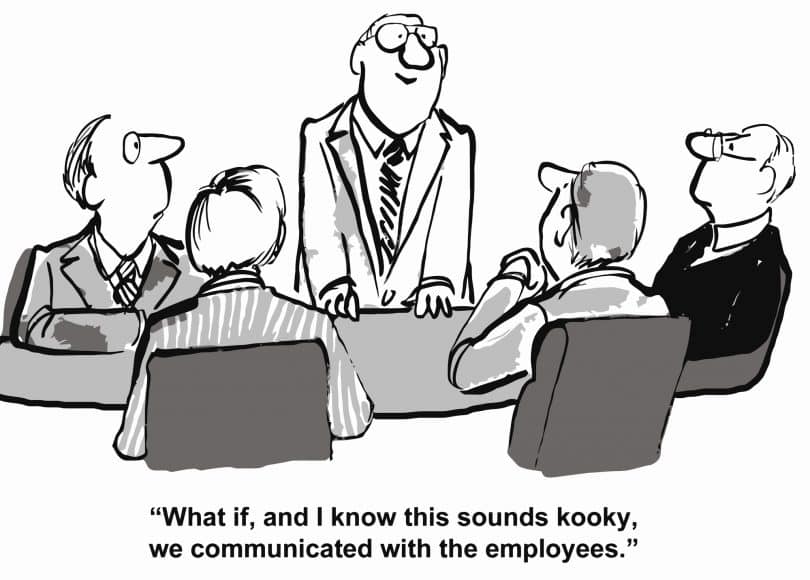WHY?
“Culture eats strategy for breakfast.” – Peter Drucker
Feedback is vital to build a productive and welcoming workplace culture. At MeetingPulse, we believe in humble leadership and creating a healthy workplace culture by design.
First, we’ll guide you through the four pillars of a feedback-rich workplace, and then we’ll walk you through seven ways to approach these pillars to encourage employee feedback.
Here’s our guide to employee feedback for an efficient and healthy workplace environment.
Types of Workplace Feedback
There are various types of employee feedback, especially given recent technological solutions that provide live engagement options. Each solution comes along with its own advantages and disadvantages. The first distinction lies between one-on-one feedback and group feedback delivered at a formal or informal meeting via live survey tools, live voting platforms for important topics or other mechanisms such as audience polling software.
Traditional one-on-one conversation can result in the illusion that feedback is about that particular relationship dynamic, when in truth it is a reflection of the larger social and cultural structures in place. On the other hand, individuals who aren’t fans of one-on-one feedback may feel more comfortable participating in group feedback activities.
But even if employees want a feedback-friendly culture, they can’t create a feedback-rich workplace alone. Leaders must set an example by providing an array of options opportunities for employee feedback so that every participant has a chance to contribute in a way that works well for them.
Even if an employee truly wants to provide constructive honest feedback, they will eventually give up if their organization doesn’t support a type of communication that works for them.
Feedback is a pillar of success for every company. Feedback is a two-way street, and giving employee feedback and gathering employee feedback are equally important. First, we’ll walk you through delivering both positive and negative feedback. Then, we’ll talk about the pillars of a feedback-rich environment and how anonymous feedback can encourage your employees to give their thoughts to you.
The 4 Pillars of a Feedback-Rich Workplace
In Radical Candor, Kim Scott writes, “The way you ask for criticism and react when you get it goes a long way toward building trust—or destroying it.”
Remember, delivering negative feedback is all about your tone and articulation — these components are the difference between sounding rude and intimidating, or constructive and helpful.
Similarly, ask for feedback in a way that makes employees feel like their opinions are welcomed, not mandated, and that you’re opening to hearing the positive and the negative.
We believe in the power of healthy interpersonal feedback in the workplace. That’s what MeetingPulse is all about. Employees need to have a well-rounded understanding of their impact on others and their organization in order to feel truly productive and fulfilled at work. Direct employee feedback, either via technology or in person, is the most effective way for team members to access this information.
The 4 Pillars of a Feedback-Rich Workplace
According to Ed Batista from the Stanford Graduate School of Business, these are the essential elements to creating a feedback-rich work environment:
- Safety and trust
- Balance
- Normalization
- Personal Accountability
Safety and Trust
In order for participants to both give and remain open to receiving candid feedback, a sense of safety and trust must exist. This means that organizational leaders must be highly attuned to people’s unique needs, abilities, and their emotional experiences. Healthy workplace communication requires a willingness to observe and listen.
Safety and trust can be created in a few ways. Firstly, it helps when co-workers get to know each other as individuals. Perhaps they ask about each others’ families or recent vacation.
Secondly, talking about emotions allows team members to air out challenging feelings. A feedback-friendly workplace allows employees to talk about the tough stuff when necessary.
Thirdly, everyone needs to feel comfortable and free to keep boundaries that feel safe for them. If someone says that they aren’t ready to talk about something, it’s best to discuss their hesitancy or wait until they are in a more receptive frame of mind.
Balance
A great feedback culture isn’t primarily based upon criticism — strong relationships grow when positive feedback is a regular and accepted part of workplace communication.
Consider offering positive feedback and acknowledgements regularly. Refrain from using positive feedback to cushion the blow before delivering criticism.
Everyone knows about the “compliment sandwich.” This common technique lessens the impact of positive feedback and decreases trust. It trains team members to distrust complements.
Provide feedback around the tiny things that someone is great at — or the positives that their shining personality brings to the group dynamic. Also, help your team members to understand that you see when they are trying their best. Don’t solely praise outcomes — praise all of the hard work that goes into a process.
Normalization
Create healthy patterns that help your team to recognize new patterns of normalcy. Regularly integrate your efforts to create a feedback-friendly workplace.
Over time, healthier and more desirable behaviors will become routine and comfortable. If feedback only happens once a quarter, day-to-day workplace culture will change very little.
So don’t wait for a special occasion. Integrate live feedback into group activities so that everyone is included — and so that everyone gets the message that this type of activity is something for everyone. Over time, a more positive workplace culture will evolve.
Personal Accountability
If you want to show your employees that feedback is important to you, then walk the talk. If the values on your website or in a speech you give at a big event aren’t in alignment with the way you run your organization, employees will see that and it will decrease trust and dilute those values across your organization.
Try your best to test out live feedback methods and see where that leads. Do research regarding the various communication tools and techniques out there — and be willing to fail. Let your employees know that you’re trying to improve your constructive feedback skills. Importantly, be transparent about your goal to create a more feedback-rich workplace. Allow employees to share in that goal.
As a leader, it’s important that you actively ask for feedback. Don’t expect your employees to take the lead. Show them that you value their opinions by asking them to share how they feel about their workplace experience.
We built MeetingPulse with the mission to use live feedback technology to support healthy corporate culture by making these four pillars easy to follow and implement.
Now that you know what a feedback-rich workplace is, it’s time to learn how to create one.
Creating a Feedback Friendly Workplace

In her book Radical Candor, Kim Malone Scott writes, “Being overly focused on respect can backfire because it’ll make you feel extra defensive when criticized. If, on the other hand, you can listen to the criticism and react well to it, both trust and respect will follow.”
The ethos of focusing on feedback rather than respect encourages a workplace environment that’s collaborative and built on trust and mutual courtesy. In order to achieve this, employers must signpost to their employees that they’re willing to listen.
Trust, balance, normalization, and accountability are the building blocks for creating a feedback-rich environment. But still, getting honest feedback from employees can feel a bit like a treasure hunt — unless you have a clear process. How does one create a feedback system that encourages constructive input? What are some effective strategies for catching the small problems before they grow into bigger ones?
Here are seven actionable steps you can take that will help you adhere to the pillars of a feedback-rich environment.
Related: How to Get People to Take a Survey
Communicate Your Interest in Employee Feedback
First, employees need to know that you are actually interested in their feedback and ideas. Be honest with them about your interest so that they can be honest with you about their insights. No one wants to send their boss unsolicited complaints, criticism or suggestions.
Let them know that you prefer hearing their input — that doing so is part of being a good employee. Just as you are free to be honest with your employees, let them know that you want honesty in return. Increase employee engagement through honest interaction that allows them to participate actively.

Be Proactive & Get Personal
Kim Scott writes, “Make sure that you are seeing each person on your team with fresh eyes every day. People evolve, and so your relationships must evolve with them. Care personally; don’t put people in boxes and leave them there.” In order to constantly refresh how you view your employees, it’s necessary to give them a push in the right direction.
Don’t wait for employees to come forward with feedback on their own. While some employees are eager and comfortable with feedback processes, it won’t come naturally to others. Integrate employee feedback into the culture of your company by hosting feedback-focused gatherings.
Make yourself approachable and set a good example. Invite feedback with an open-minded, humble, and supportive attitude. Use discussions to build trust in the employee feedback process. Let them sense your interest and curiosity firsthand. Ask well-tailored questions that encourage employee engagement while helping you gain valuable insight.
Create a Feedback Guide
Create a guide describing how and when to provide feedback. List the established methods and best practices at your organization. This should include analog methods along with technological methods that are well-designed and user-friendly.
Provide examples of well-written feedback submissions. Describe and demonstrate the differences between productive and unproductive feedback. Discuss when to share coworker names or situational details — and when it’s best to refrain.
Train your employees to format constructive feedback in a productive and respectful manner. Describe how providing feedback can increase employee engagement and satisfaction — thus improving the work experience for everyone.
Integrate Feedback Technology
Consider using a live audience and employee feedback system during these events to poll and survey your group. These are handy as well for allowing everyone present to submit questions and vote on what topics or questions they find most relevant. Consider browser-based systems that decrease barriers to participation.
When employees have to download special apps or software, some may be left out of the process due to technical problems. Consider small and larger apps that can assist the gathering of employee feedback and queries both during meetings — or over longer periods of time via regular surveys or open calls for input.
Build Trust
Ensure your teams that there will be no negative repercussions for thoughtfully submitted employee feedback and that their information will be kept confidential. Set up a system that allows employees to feel safe about how their input will be processed and who will have access to it. Inform employees about the way their input will be used and describe the process that they are supporting through their personal sharing. Create a feedback system that works comfortably for everyone involved.

Address Privacy Concerns
Anonymous feedback is a great way to give employees a platform to provide detailed suggestions and feedback as needed while protecting their identity. Again, this all goes back to respect and trust, as Kim Scott writes in Radical Candor. Anonymous feedback tells employees that you truly want to hear what they have to say, even if that means tough, constructive criticism.
Craft a Culture of Open Communication
This one takes time. Building culture requires a long term commitment and consistency. But over time, if the leaders in your organization champion open communication, it will slowly but surely become an instilled part of your corporate culture. Constantly improve the feedback systems in place at your organization.
Most importantly, let them see and enjoy the fruits of their labor. Let employees know that their perspectives and concerns are truly valued and that there is genuine consideration and change. Clearly present the results of a shared process and highlight the benefits of honesty and cooperation. When everyone understands that healthy communication is a win-win, the barriers to proactive participation will fall away naturally over time.
The MeetingPulse Solution
In summary, it’s ideal to generate a feedback culture where you’re eager to hear what your employees have to say and they’re eager to hear what you have to say. Whether they’re giving you insight on the efficiency of meetings or commending you for your inspirational leadership, keeping conversation lines open for feedback is key.
At MeetingPulse, we allow you to quickly and easily customize the employee feedback experience to fit the personality of your organization. If you are in the process of shifting your organizational culture to a more open and cooperative system, we would like to help you to make this change.
In order to learn more about our browser-based employee feedback app and how it can improve your organizational culture, reach out to us directly for a free trial or sign up on our blog page to receive blog updates and our free ebook.






